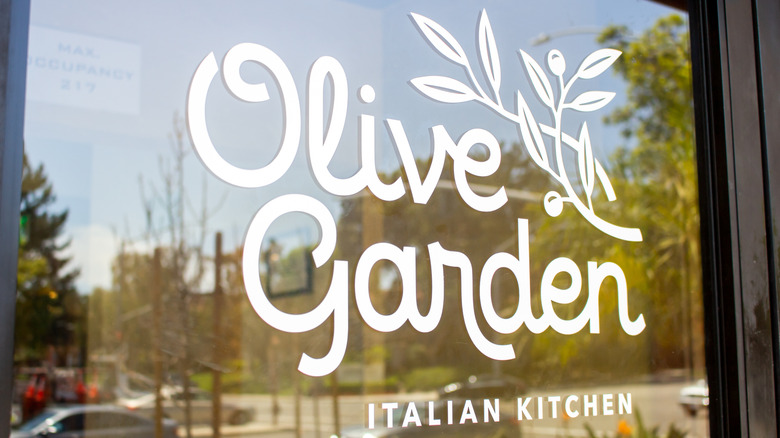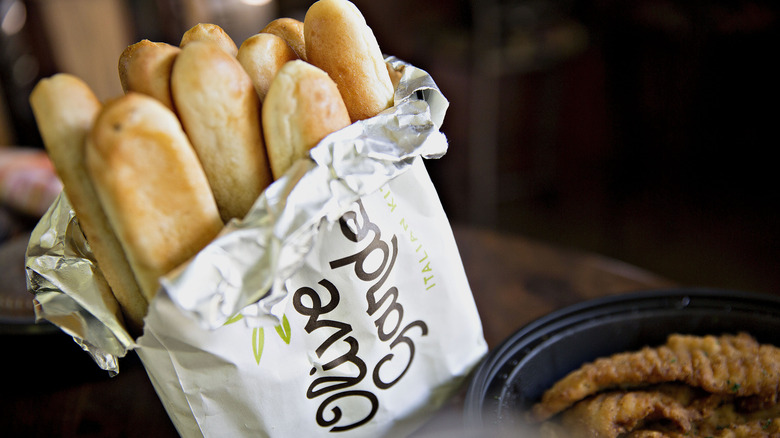Olive Garden Had Huge Expansion Plans Right From The Get-Go
For a restaurant chain as big as Olive Garden, people have a lot of thoughts about it. For some, Olive Garden provides an easy introduction to Italian-American cuisine, through generous portions and a variety of pasta dishes, soups, salads, and breadsticks. For others, the ubiquity of the restaurant and fast-casual environment means that, while the food tends to be consistent and familiar, it may not be the first pick for a special night out.
Today, there are more than 900 global locations of Olive Garden, about 880 of them located in the United States and the rest in other countries. Based on the family-style recipes, it's easy to think that the chain started as a small mom-and-pop food business that really found its footing, perhaps like the duo behind the ice cream brand Häagen-Dazs. But, Olive Garden was no scrappy operation, and the very well-known owners had big plans for the restaurant from the start.
Olive Garden was actually founded by General Mills, Inc., the giant American food company, and the first location of the restaurant opened in December 1982 in Orlando, Florida before it started to expand nationally and globally. When a giant brand like General Mills invests in a restaurant, you know they are looking for their returns, both financially and through brand recognition, and so it was very unlikely that Olive Garden could stay small for long.
Olive Garden started expanding rapidly in the 1980s
If you're wondering why General Mills, the company behind Betty Crocker and Nature Valley, got into the restaurant business in the first place, that story predates even Olive Garden's origins and goes back to 1970 when the founder of Red Lobster, Bill Darden, sold off his enterprise to the food giant. General Mills' large network helped expand the seafood restaurant chain to nearly every corner of the United States. Perhaps inspired by this success, the company looked into replicating it with another chain, this time one offering Italian food.
While everything started with that one Olive Garden in Orlando in 1982, Bill Lombardo, then-marketing director for General Mills' Creative Dining division told the Orlando Sentinel in 1987 that the company "sat tight for three years, studying the restaurants' operations and drafting manuals and strategies to be followed by new outlets."
This analysis and patience paid off because, by 1987, there were 36 Olive Gardens operating nationally. By 1989, there were 145 locations. And today, there are more than 900 places to get that delectable alfredo, including in Canada and Mexico.
Today, General Mills is not part of the restaurant group
One of the reasons why General Mills could expand the Olive Garden chain so rapidly in the 1980s and 1990s is because the company had experience managing chain restaurants and knew how to get a new location up and running quickly. For example, back then, their modus operandi was to take over existing restaurant sites and convert them into new Olive Gardens, rather than building new restaurants from scratch. This saved both time and money.
These days, General Mills has gotten out of the restaurant business and exists solely as a consumer food company. Despite the success of Red Lobster and Olive Garden, General Mills spun their former restaurant division off into a new independent company called Darden Restaurants in 1995 (yes, after original Red Lobster owner Bill Darden). The group also currently owns restaurant chains like LongHorn Steakhouse and Yard House, among others.
The '90s is also the time when Darden executives started to sell the idea that Olive Garden was as homely spot to get an Italian family dinner. The building exterior morphed into Tuscan farmhouse vibes, and, inside, the tables were big and family-sized. The tagline, "We're all family here" is a bit on the nose, but it still remains a perfect setting for those all-you-can-eat unlimited breadsticks.


